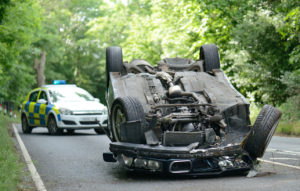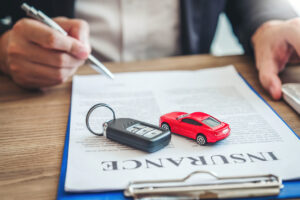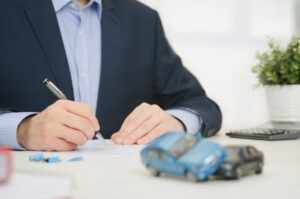John Austin | December 26, 2020 | Car Accidents
Injured victims endure worsening health and financial distress after sustaining an injury in a car crash. You may be entitled to compensation after sustaining an injury in a collision caused by someone else’s negligence.
Even so, you must demonstrate how the negligent party’s actions contributed to your losses. While vehicle damage patterns can provide valuable clues about how an accident occurred, they don’t always tell the complete story. Insurance adjusters and opposing parties often use damage analysis to shift blame or dispute liability, leaving injured victims struggling to prove their case. However, a legal professional can guide you in proving fault and protecting your rights.
At Roman Austin, our experienced car accident lawyers understand how to analyze vehicle damage, gather supporting evidence, and build compelling cases that prove fault. We work with accident reconstruction experts, investigate the crash, and fight aggressively to ensure you receive a fair and just settlement.
Car Accidents Key Takeaways
- Vehicle damage, police reports, witness accounts, and expert reconstruction help determine who hit whom in a car accident.
- Intersection crashes often involve shared liability, with fault depending on traffic laws, right-of-way, and driver behavior.
- Car accident settlements may take months to years, depending on injury severity, liability disputes, and insurer cooperation.
- After an accident, not your fault, seek medical care, inform the police, and consult a car accident lawyer before speaking with insurers.
- Most car accident cases settle, but some proceed to court if insurers dispute liability or offer unfair settlements.
- Call a car accident attorney to establish liability and fight for a fair and just settlement.
How to Tell Who Hit Whom in a Car Accident
Determining fault in a car accident requires careful examination of multiple evidence sources. Insurance companies, attorneys, and courts rely on various types of proof to establish liability and assign responsibility.
Here are various types of evidence to determine fault in a car crash:
Vehicle Damage Analysis

Vehicle damage patterns can provide insights into how the accident occurred. The location, severity, and type of damage can reveal impact angles, speeds, and the sequence of events.
For example, rear-end collisions show front-end damage on one vehicle and rear-end damage on another, while T-bone accidents create distinct side-impact patterns. A car accident lawyer can use investigators and accident reconstruction experts to interpret these damage patterns and determine fault.
Police Crash Reports
Law enforcement officers create official accident reports containing their professional assessment of the scene. These reports include officer observations, preliminary fault determinations, citations issued, and witness statements collected at the scene.
While not always admissible in court, police reports can support an insurance claim. They can also provide third-party perspectives on accident circumstances.
Eyewitness Testimony
Independent witnesses who observed the accident provide unbiased accounts of events. Their testimonies can confirm or contradict driver statements and help establish the events leading to the collision.
Witness credibility depends on their vantage point, attention level, and ability to recall details accurately. Multiple consistent witness accounts strengthen liability claims significantly.
Traffic Camera and Surveillance Footage
Video evidence from traffic cameras, security systems, or dashcams offers objective documentation of accident events. Surveillance footage can show traffic signal compliance, vehicle speeds, lane changes, and driver behavior immediately before impact.
Video evidence is particularly valuable because it captures real-time events without relying on human memory or perception.
Physical Evidence from the Accident Scene
Skid marks, debris fields, road gouges, and tire impressions provide information about accident dynamics. For example, kid marks indicate braking patterns and vehicle paths. On the other hand, debris distribution helps establish impact points and post-collision movements.
A car accident attorney can help you preserve physical evidence before weather conditions or traffic clear the scene.
Driver Statements and Admissions
Statements made by drivers at the accident scene, to police officers, or to insurance representatives can establish liability.
Admissions of fault, apologies, or descriptions of events leading to the crash provide direct evidence of responsibility.
Traffic Violation Citations and Records
Citations issued at the accident scene or traffic violations leading to the crash establish negligent behavior. Running red lights, speeding, improper lane changes, or driving under the influence create strong liability presumptions.
Driver history records showing patterns of violations can also support fault determinations.
Accident Reconstruction Analysis
Professional accident reconstructionists use engineering principles, physics, and specialized software to recreate accident scenarios. They analyze vehicle damage, road conditions, weather factors, and physical evidence to determine speeds, impact angles, and driver actions.
Expert testimony provides scientific backing for liability claims and helps explain complex accident dynamics to insurance adjusters and juries.
Who Is at Fault in a Car Accident in an Intersection
Establishing fault in an intersection crash is challenging because multiple parties may share responsibility. A car accident lawyer can prove fault by examining traffic laws, signal compliance, and driver behavior leading up to the collision.
Here are parties who may be liable for a crash at an intersection:
Negligent Drivers
Drivers may be liable for a crash at an intersection due to various reasons, including:
- Traffic signal violators are often primarily at fault when they run red lights or fail to yield at yellow signals. Drivers who enter intersections against traffic control devices bear significant responsibility for resulting crashes.
- Right-of-way violators include drivers who fail to yield when turning left, entering from side streets, or merging into traffic. Left-turning drivers are frequently at fault when colliding with oncoming traffic, unless the oncoming vehicle was speeding or ran a red light.
- Speeding Drivers who exceed posted limits or drive too fast for conditions may be liable even if they had the right-of-way. Excessive speed reduces reaction time and increases collision severity.
- Distracted or Impaired Drivers who fail to notice traffic signals, other vehicles, or road conditions due to texting, phone calls, intoxication, or other distractions bear responsibility for intersection crashes.
Third Parties
Sometimes, crashes involve more than just the drivers on the road. Identifying third-party responsibility can strengthen your case and expand opportunities to recover compensation. Here are examples of third parties who may be liable for the car crash:
- Government entities may be liable for poorly designed intersections, malfunctioning traffic signals, inadequate signage, or dangerous road conditions. Municipalities have duties to maintain safe traffic control systems.
- Construction companies working near intersections may be responsible if inadequate safety measures, poor signage, or equipment placement contributed to accidents.
- Other drivers involved in multi-vehicle crashes may share fault through chain reaction collisions or failure to avoid preventable secondary impacts.
- Property owners may bear responsibility if overgrown vegetation, improperly placed signs, or structures obstruct driver visibility at intersections.
Shared Liability
Many intersection accidents involve shared fault, where multiple parties share responsibility for the crash. For example, a left-turning driver might be 70 percent at fault while a speeding oncoming driver bears 30 percent responsibility.
A car accident lawyer can protect you from unfair blame using police reports, eyewitness testimony, and accident reconstruction expert findings to challenge exaggerated fault claims.
For example, if the insurer argues you were speeding, a car accident attorney can present traffic camera footage and skid mark analysis showing the other driver ran a red light, reducing or eliminating your percentage of fault.
How Long Does the Car Accident Settlement Take

Car accident settlements can range from a few months to several years, depending on the applicable facts and circumstances. While some straightforward claims resolve quickly, complex cases involving serious injuries or disputed liability often require extensive time for investigation and negotiation.
Here are the factors that influence how long it takes to settle a car crash:
Severity and Complexity of Injuries
Minor injuries like sprains or cuts typically resolve faster because medical treatment and time off work are brief. However, victims with serious injuries requiring surgery, long-term rehabilitation, or permanent disability endure a lengthy timeline.
A car accident attorney must wait until you reach maximum medical improvement to estimate future medical costs, lost earning capacity, and pain and suffering. It takes years to understand the losses associated with catastrophic injuries like spinal cord damage or traumatic brain injuries, delaying final settlement negotiations.
Liability Disputes and Fault Determination
Clear-cut cases where fault is obvious settle much faster than accidents involving disputed liability. The settlement process may be delayed when both parties claim innocence or multiple vehicles are involved.
The actions of insurance companies could also delay the settlement process. For example, they may hire accident reconstruction experts, conduct detailed scene analysis, and interview numerous witnesses.
Insurance Company Cooperation and Resources
Some insurance companies employ delay tactics to pressure claimants into accepting lower settlements. Large insurance companies typically have more resources for quick claim processing, but may also have more rigid settlement procedures.
Smaller insurers might lack adequate staff or financial resources to handle claims promptly. The specific adjuster assigned to your case can also impact processing speed and the settlement process.
Available Insurance Coverage Limits
Cases where damages exceed available insurance coverage can delay the settlement process. When injury costs surpass policy limits, a car accident attorney must pursue additional compensation sources, such as umbrella policies, personal assets, or multiple liable parties.
These investigations and negotiations with several insurers or defendants naturally extend settlement timelines. Conversely, cases where damages fall well within policy limits often resolve more quickly.
Legal Representation
An experienced car accident attorney understands how to gather evidence, negotiate with insurers, and push cases toward resolution. They also know when to be patient and thorough to maximize compensation.
Some cases benefit from immediate settlement to avoid litigation costs, while others require extended negotiation or trial preparation to achieve fair outcomes. The strategy and workload of a car accident lawyer can influence how quickly your case progresses through the settlement process.
What to Do After a Car Accident Not Your Fault
After a car accident that wasn’t your fault, seek medical attention immediately, even if you feel fine after the crash. Contact the police and your insurance company, but avoid engaging in settlement negotiations without a car accident lawyer.
Most importantly, consult a car accident attorney before making statements or accepting settlement offers. An experienced car accident attorney will guide you through the process, explain your rights, and help you make informed decisions that preserve your right to compensation.
Get Legal Support to Face the Aftermath of a Car Crash
Your quality of life is likely to worsen after being injured in a car crash caused by someone else’s negligence. For example, an amputated arm can prevent you from participating in evening jogs, your favorite activity.

Despite your legal right to compensation, the insurer may frustrate you by rejecting your claim or making a low settlement offer. A car accident lawyer from Roman Austin can gather compelling evidence to prove fault, negotiate with insurers, or litigate to maximize recovery.
Contact us at (727) 787-2500 for a free case evaluation.
Car Crashes Frequently Asked Questions
Do Car Accident Claims Expire
Yes, car accident claims expire based on statutes of limitations that vary by state. These deadlines typically range from one to six years for personal injury claims. Missing these deadlines means losing your right to seek compensation forever.
Consult a car accident lawyer immediately after your accident to understand your state’s specific time limits and protect your legal rights.
How Much Is a Car Accident Lawyer
The cost of hiring a car accident attorney varies based on several factors, including case complexity, severity of injuries, amount of damages, and time required for resolution. Most attorneys work on contingency fees, meaning you pay nothing up front and they only collect if you win.
Additional factors influencing the overall cost include insurance company cooperation, the need for expert witnesses, and potential litigation.
What to Ask a Car Accident Lawyer
When hiring a car accident attorney, ask about their experience with similar cases, success rate, fee structure, and case timeline. Inquire about their trial experience, resources for investigation, communication frequency, and staff involvement.
Ask how they’ll handle insurance negotiations, what damages they’ll pursue, and their assessment of your case and potential value.
Will My Car Accident Go to Court
Most car accident cases settle out of court through negotiations with insurance companies. However, your case may go to trial if an insurer makes a low settlement offer or the at-fault party disputes liability.
Factors like injury severity, insurance company cooperation, and evidence strength influence this decision. An experienced car accident attorney will advise when litigation becomes necessary.


